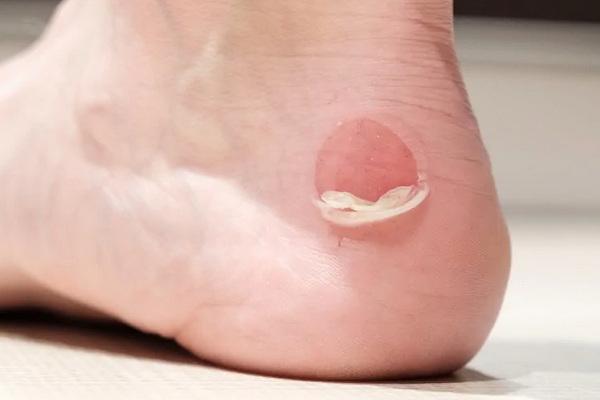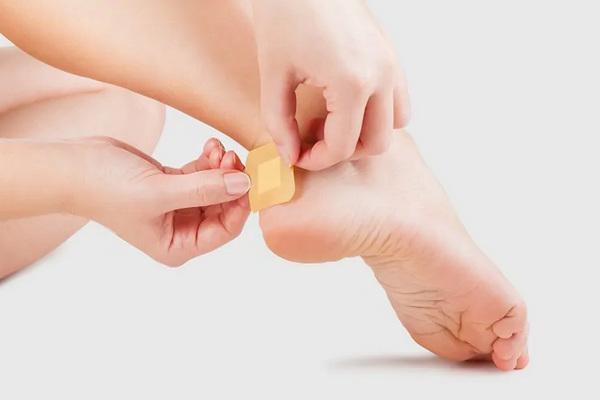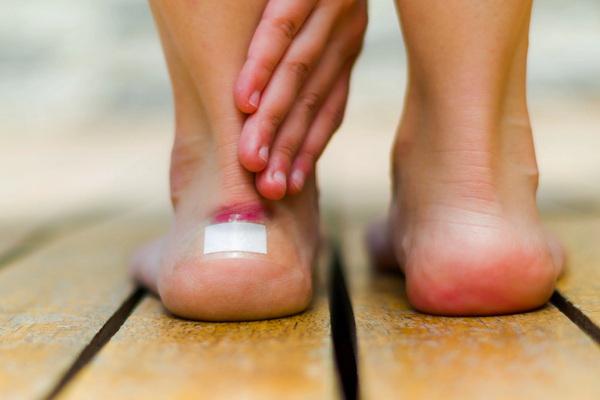Зміст
Blisters on the feet from shoes – why do they occur?

A short walk in new shoes or a long walk in long-worn, well-fitting shoes usually lead to blistering of the feet. Why is this happening? The skin consists of three layers: epidermis, dermis, and subcutaneous tissue. In a healthy person, the epidermis adheres tightly to the dermis due to complex compounds called hemi desmosomes. They ensure that when you rub the epidermis with something, it does not come off the skin.
Unfortunately, prolonged pressure, combined with the rubbing of the skin against the feet, leads to damage to the correct bonds in the skin and separation of the epidermis. Then a bladder cover forms, which quickly fills with serous fluid. Blisters appear where the pressure and friction is greatest, that is, on the heels and toes.
Blisters on the legs – how to get rid of?
If your feet already have blisters, do not worry. Fortunately, there are several ways to speed up their healing. You can make them all yourself at home. However, do not trust the old methods for blistering your feet. Home remedies like cabbage wrap or spread with honey can backfire – they just irritate the skin and slow down its healing.
What to do then? As soon as you see blisters on your feet, do not hesitate – take action. The earlier you start treatment, the less time it may take. Also, remember that a lot depends on your individual circumstances. Some people, especially those with diabetes, may have natural problems with quick wound healing and skin damage.
What will help with blistering feet?
First, wash your skin with soap and water to remove dirt and sweat.
Disinfect your skin with a skin cleanser. If the blister is small, protect it and put on a special patch with a bandage specifically for blisters. Never stick the patch without a bandage, because when you take it off, you will expose the bladder cover.
Torn blisters on the legs – what to do?

If you do not catch the moment of the formation of the bubble, you may notice torn blisters on the legs. What then? Do the same as for the intact bubble. It will be especially important here to choose the right dressing that does not stick to the bladder wound. Even if the exfoliated epidermis has partially penetrated inside, never cut off its remnants! The wound should heal on its own, and excision can only exacerbate the damage to the surrounding tissues.
A hydrogel patch is a good solution for chapped leg blisters:
“If the bladder rupture is in an area subject to further abrasion, or if you cannot allow it to heal safely at home without shoes, a suitable bandage is a good solution.
You can use a regular patch with a sterile bandage or a hydrogel patch. The latter option is slightly more convenient because it insulates the wound well and prevents further injury. In addition, the hydrogel used in the dressing maintains a moist environment and gas exchange. This optimizes and promotes the healing of damaged skin.
The hydrogel patch is also easy to use – it does not need to be changed as often. This reduces the risk of damage to the healing wound – you can simply break the epidermis that has just been regenerated with the bandage. And the whole process will start over. Therefore, remember that if you are covering the bladder with a regular sterile patch, remove the dressing very carefully so as not to damage the double wound
If you want to speed up the healing process, give your skin air. When you have the opportunity, for example at home, take off your shoes, socks, and bandages so that your skin can “breathe”.
Unfortunately, there is no magical way to cure leg blisters. If a bubble of serous fluid has already formed, it takes time to heal. However, it is worth following these rules. They will shorten the healing process and reduce the risk of complications such as secondary bacterial skin infections.
Will ointments help for blisters? Do not apply ointment directly to the wound. Just disinfect it. Applying ointments or other medications directly to the injury can impair healing, irritation, and additional pain.
Cracked bladder on the foot – treatment by a doctor?
“Do blisters on your legs heal badly? If your toe near the bladder becomes inflamed, has a large, painful sore, or develops an infection, do not hesitate and see your doctor. The bladder on the foot of a diabetic deserves special attention. All injuries and wounds on the feet of diabetics require attention and control. Diabetics are more likely to heal worse, take longer, and get leg infections. ”
Blisters on the fingers – how to deal with it?
“If you already have a blister on your toe, act quickly. Treatment is no different from that for blistering legs (below). Wrap the vial and pierce if necessary. Here, too, I recommend using a hydrogel patch. This one will well protect the bubble on the finger, i.e. in a rather sensitive place. If possible, if you are not in the middle of the tour, try to change into more comfortable shoes, preferably one that does not press on the bubble. ”
To summarize, how to treat blisters on your feet?
Blisters on the legs press, burn, hurt, and cause discomfort. If you are planning to put on new shoes and are worried about chafing and blistering on your foot, do it in stages. First, put on new shoes for short trips or start wearing them at home. When the bladder has formed, rinse, disinfect and finally pierce. Be sure to protect the wound well so that it heals quickly and does not hurt you.








